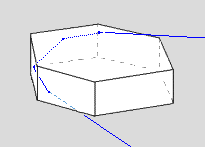
OPOD
What's New
Rays & Shadows
Water Droplets
Rainbows
Ice Halos
Contents
Crystals
Frequent Halos
Infrequent Halos
Why infrequent?
46° Halo
Supra/infralateral
Parry Arcs
Lowitz Arcs
Moilanen Arc
Kern Arc
120° Parhelia
Image
44° Parhelia
Subhorizon Arcs
Pyramidal
Multiple Displays
Other Worlds
Observing Halos
HaloSim
High Atmosphere
Links & Resources
Search - Index
123456789012345678
| 120� Parhelia |
| A 120� parhelion brightens the parhelic circle. Far from the sun, these parhelia arise from multiple reflections inside relatively thick oriented plate crystals. To the right of the 120� parhelion, the otherwise colourless parhelic circle is very slightly blue ~ the 'blue spot'. Further right around the anthelic point (the point opposite to the sun but at the same altitude), singly oriented columns generate even more exotic halos. HaloSim simulation centered 150� from a 15� high sun. | ||||||
The parhelia result from at least two internal reflections. Rays enter the plate crystal top face, internally reflect off two adjacent side faces then leave through the lower face. The horizontal deflection of the ray is always 120� regardless of the angle of incidence of the incoming ray ~ hence the parhelion rather than yet another parhelic circle ray. |
||||||
